Forget me knot: Gego's wiry works are back in the spotlight

For those unfamiliar with the legacy of Gertrude Goldshmidt (or Gego, as she is popularly known), a comprehensive exhibition of works, currently on show at Dominique Lévy's Upper East Side gallery in New York, is poised to reveal all. 'Gego: Autobiography of a Line' is an inspiring tribute to the 20th century icon, who trained as an architect prior to becoming an artist. Born in Hamburg, Germany in 1912, and then based in Venezuela after fleeing the Nazis, Gego's intricately woven, three-dimensional works explore the power of the simple line.
Thanks to the support of Fundación Gego and several other art institutions in Venezuela and Latin America who temporarily parted with pieces for the exhibition, Dominique Levy's show brings many of Gego's key works back into view, including her famed Chorros series, last seen in New York in 1971. Constructed from knotted wires that delicately graze the ground, these slender, towering sculptures (the title of which translates to 'waterfalls') encapsulates the unique sense of space that Gego possessed.
'It's very difficult to do something different with Gego because there have been many well-curated exhibitions before, but I think we hit the nail on the head when we decided to focus the show on her relationship with the material,' says Jesús Fuenmayor, who helped to organise the exhibition. 'It's amazing that this woman was working for over 40 years with metal. She was living every single day of her life with this material and manipulating it. Few shows have ever published that particular process.'
To this end, the selection of works on display fully celebrates Gego's remarkable approach, which is consistently palpable regardless of medium. From drawings on paper that articulate the same methods of tying together metal in her sculptures, to collages and intricate metal weavings (her Tejeduras works) that blur the distinctions between the drawn and sculpted line, Gego's dissections of the line covers all bases.
This New York presentation will be followed by a second exhibition of Gego's work at Dominque Levy's London space next spring, along with two new catalogues that examine her work in a contemporary context.
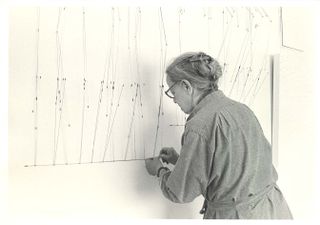
The show is an inspiring tribute to the 20th century icon, who trained as an architect prior to becoming an artist. Pictured: Gego in her studio, 1984. copyright Fundación Gego
Her famed Chorros series was constructed from knotted wires that delicately grazed the ground – slender, towering sculptures that encapsulate the unique sense of space that Gego possessed.

Pictured: Gego at CIR (Centre for Interamerican Relations), New York, 1969 (left); and installation view of Chorros at Betty Parsons Gallery, New York, 1971 (right). copyright Fundación Gego
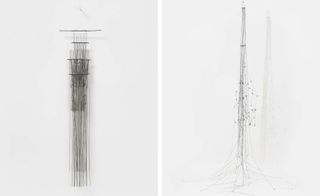
Dibujo sin papel 78/3, 1978 (left); and Chorro N° 9, 1971 (right). copyright Fundación Gego
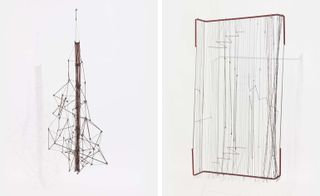
Chorro N° 3, 1970 (left); and Dibujo sin papel 88/28,1988 (right). copyright Fundación Gego

A close-up (left) and installation view (right) of Chorros at Betty Parsons Gallery, New York, 1971. copyright Fundación Gego
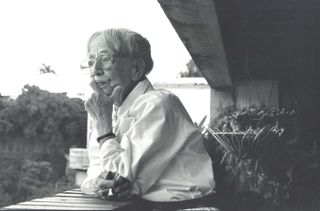
’It’s very difficult to do something different with Gego because there have been many well-curated exhibitions before, but I think we hit the nail on the head when we decided to focus the show on her relationship with the material,’ says Jesús Fuenmayor, who helped to organise the exhibition. Pictured: Gego, 1988. copyright Fundación Gego

’It’s amazing that this woman was working for over 40 years with metal. She was living every single day of her life with this material and manipulating it. Few shows have ever published that particular process,’ he adds. Pictured: Gego at Museo de Arte Contemporáneo de Caracas, 1977. copyright Fundación Gego
INFORMATION
’Gego: Autobiography of a Line’ is on show at Dominique Levy until 24 October
ADDRESS
Dominique Levy
909 Madion Avenue at 73rd Street
New York, NY 10021
Wallpaper* Newsletter
Receive our daily digest of inspiration, escapism and design stories from around the world direct to your inbox
Pei-Ru Keh is a former US Editor at Wallpaper*. Born and raised in Singapore, she has been a New Yorker since 2013. Pei-Ru held various titles at Wallpaper* between 2007 and 2023. She reports on design, tech, art, architecture, fashion, beauty and lifestyle happenings in the United States, both in print and digitally. Pei-Ru took a key role in championing diversity and representation within Wallpaper's content pillars, actively seeking out stories that reflect a wide range of perspectives. She lives in Brooklyn with her husband and two children, and is currently learning how to drive.
-
 Utilitarian men’s fashion that will elevate your everyday
Utilitarian men’s fashion that will elevate your everydayFrom Prada to Margaret Howell, utilitarian and workwear-inspired men’s fashion gets an upgrade for S/S 2024
By Jack Moss Published
-
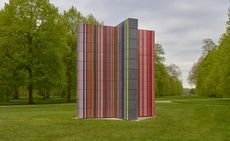 Gerhard Richter unveils new sculpture at Serpentine South
Gerhard Richter unveils new sculpture at Serpentine SouthGerhard Richter revisits themes of pattern and repetition in ‘Strip-Tower’ at London’s Serpentine South
By Hannah Silver Published
-
 Vipp’s Scandinavian guesthouse offers a sleek setting amid a wild landscape
Vipp’s Scandinavian guesthouse offers a sleek setting amid a wild landscapeVipp Cold Hawaii is a Scandinavian guesthouse designed by architecture studio Hahn Lavsen in Denmark’s Thy National Park
By Sofia de la Cruz Published